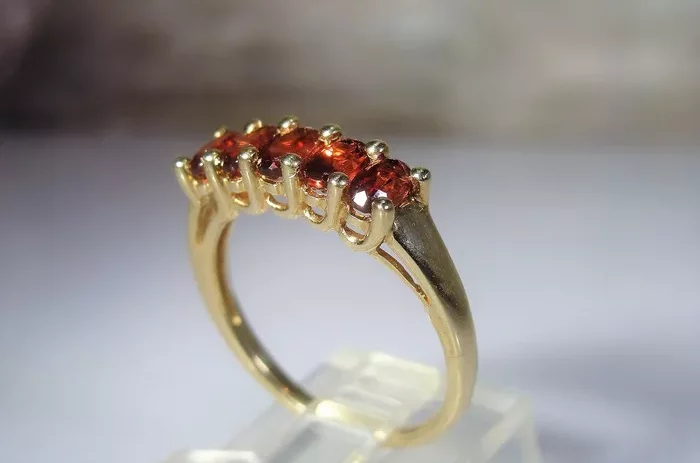Silver garnet, often referred to as garnet, is a fascinating gemstone that captivates both gem enthusiasts and casual admirers alike. This article delves into the intricacies of silver garnet, exploring its properties, origins, and significance in the world of gemology. By presenting this information in a clear and engaging manner, we aim to enhance your understanding and appreciation of this remarkable gemstone.
What is Silver Garnet?
Silver garnet is a member of the garnet group, a family of silicate minerals that share a similar crystal structure but vary in composition. The term “silver garnet” typically refers to a specific type of garnet known as andradite, which can exhibit a range of colors, including green, yellow, and the striking silver hue that gives it its name.
Composition and Varieties
Garnets are classified into several species based on their chemical composition, including:
Almandine: Reddish-brown garnet, commonly found in metamorphic rocks.
Pyrope: Deep red garnet, often used in jewelry.
Spessartine: Orange to reddish garnet, known for its vibrant color.
Grossular: Ranges from green to yellow, with varieties like tsavorite (green) and hessonite (orange-brown).
Andradite: Includes the silver garnet, known for its unique colors and brilliance.
The specific chemical formula for andradite is Ca3Fe2(SiO4)3, where iron can be replaced by other elements, leading to variations in color and properties.
Physical Properties of Silver Garnet
Silver garnet possesses several notable physical properties that contribute to its desirability in the gemstone market:
Hardness: On the Mohs scale, silver garnet ranks between 6.5 and 7.5, making it suitable for everyday wear in jewelry.
Luster: It exhibits a vitreous to resinous luster, enhancing its visual appeal.
Color: The silver hue can range from light gray to a deeper, more metallic tone, often with inclusions that add character.
Transparency: While some varieties are transparent, others may be translucent, affecting their value and use in jewelry.
These properties not only make silver garnet attractive but also durable, allowing it to withstand the rigors of daily wear.
See Also: What is Bishop’s Garnet?
Origins and Formation
Silver garnet forms in metamorphic and igneous environments, typically within high-temperature and high-pressure conditions. The geological processes that lead to the formation of garnets can take millions of years, involving the transformation of existing rocks under extreme conditions.
Metamorphic Formation: Garnets often form in metamorphic rocks, where pre-existing minerals undergo changes due to heat and pressure. This process can create beautiful crystals that are later mined for use as gemstones.
Igneous Formation: In some cases, garnets crystallize from molten rock (magma) as it cools, contributing to the diversity of garnet types found in nature.
Geographic Distribution
Silver garnet can be found in various locations around the world, each contributing unique characteristics to the gemstones sourced from these regions. Notable sources include:
Brazil: Known for producing high-quality garnets, including andradite.
Russia: Particularly in the Ural Mountains, where various garnet types are mined.
United States: States like New York and Vermont have deposits of garnet, often used for industrial purposes as well as gemstones.
Africa: Countries like Madagascar and Tanzania are emerging as significant sources of garnets, including the silver variety.
Uses of Silver Garnet
Silver garnet is primarily used in jewelry, where its unique color and durability make it a popular choice for various types of adornments.
Jewelry: Silver garnet is often set in rings, necklaces, and earrings, offering a distinctive alternative to more common gemstones.
Industrial Applications: Beyond its aesthetic appeal, garnet is also used as an abrasive material in sandblasting and waterjet cutting due to its hardness.
Cultural Significance and Symbolism
Throughout history, garnets have been associated with various cultural meanings and symbolism. Silver garnet, like other garnet varieties, is often linked to:
Protection: Many cultures believed that garnets provided protection during travel and combat.
Passion and Energy: Garnets are often associated with love, passion, and energy, making them popular gifts for romantic occasions.
Healing Properties: Some believe that garnets can promote health and well-being, aiding in the healing of physical and emotional ailments.
Care and Maintenance
To ensure the longevity and beauty of silver garnet jewelry, proper care and maintenance are essential:
Cleaning: Use warm, soapy water and a soft brush to clean silver garnet. Avoid harsh chemicals that could damage the stone.
Storage: Store garnet jewelry separately to prevent scratches from harder gemstones.
Avoiding Heat: Prolonged exposure to high heat can damage garnets, so it’s advisable to remove them before engaging in activities that may expose them to extreme temperatures.
Conclusion
Silver garnet is a captivating gemstone that offers both beauty and durability, making it a valuable addition to any jewelry collection. Its unique properties, rich history, and cultural significance contribute to its allure and desirability. Whether you are a seasoned gemologist or a casual enthusiast, understanding silver garnet enhances your appreciation for this remarkable stone.
In summary, silver garnet stands out not only for its aesthetic qualities but also for its fascinating geological origins and cultural meanings. As you explore the world of gemstones, let silver garnet be a reminder of the beauty and complexity that nature has to offer.


